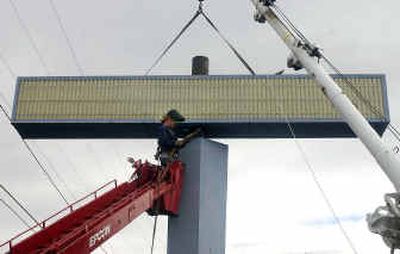Valley considers sign code

Rick Pedersen wanted a more attractive sign for his Sprague Avenue restaurant.
So the owner of Olde European Breakfast House & Bistro replaced a 30-foot-high sign outside his eatery last month with a lower, wooden one that “ties in with the theme” of his restaurant, he said.
What Pedersen got was an 18 percent boost in sales last month, something he attributes to the new marker.
“It’s right at eye level when people drive by,” he said. “When people see big signs up in the air they just see the sign, but when you drive by and it’s right there it has more of an impact.”
While Pedersen is having success with a smaller sign, the Spokane Valley City Council is considering an ordinance that would allow businesses to have bigger, taller signs that could be placed closer together in some areas. The changes, which were proposed by a council-appointed committee last year, would loosen restrictions put in place by Spokane County in 2002.
At Tuesday’s meeting, City Council members discussed some details of the proposed ordinance, but the group wasn’t ready to approve changes yet.
One issue the council debated is what happens when a sign falls down or is destroyed. Councilman Dick Denenny wants the signs that exist today to be grandfathered into the new law, so business owners wouldn’t have to change their current signs to meet the potential new regulations when they replace the sign.
The council also asked the staff to study what steps they could take to alter the blue signs on the north side of one-way Appleway Avenue that tell drivers where to turn to reach businesses on Sprague Avenue, a block away. Businesspeople and citizens have complained that those signs are too small.
The committee, composed of businesspeople and sign-industry representatives, met regularly last year to propose revisions to the sign code, which the city adopted from the county when it incorporated two years ago. The committee’s work, which has been praised for clearing up ambiguity in the law, was given a nod by the Planning Commission in a 4-2 vote and is before the council now.
The current proposal doesn’t deal with billboard regulations or signs on aesthetic corridors, issues that will be tackled later.
The committee’s meetings were open to the public, but only a few citizens attended and no one has spoken out against the proposed changes during council meetings. Tuesday’s meeting was a study session, so public comment wasn’t taken.
But criticism of the proposal has been made outside the public forum. Spokane resident Suzanne Markham said last month she has studied the proposal and doesn’t like many of the suggestions for change. She called Sprague, the city’s main commercial drag, a “glut of visual information.” And, although she doesn’t live in Spokane Valley, Markham said she’s concerned about its appearance.
“When I drive out East Sprague I don’t see a big wall that says, ‘You no longer live in this area,’ ” the graphic designer said. “I live in this area. I care about this area.”
While some businesspeople have said they depend on large signs to draw in customers, Markham thinks business activity would improve if the area were more attractive – even if that means keeping the tighter regulations.
“People are steering away from the strip mall and from areas that are not interesting or nicely landscaped,” Markham said. “A big part of drawing in new business and continuing business is coming up with a building that is interesting where the signage is good.”
At Olde European, other businesspeople haven’t inquired about Pedersen’s new sign. But customers have been showing support for it with their pocketbooks – and their words.
“Most of them say they like this sign over the big Plexiglas signs,” he said.